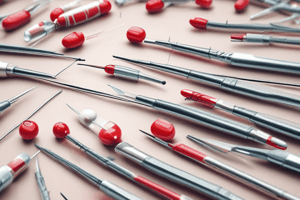Podcast
Questions and Answers
What is the first step for discarding the multisample needle?
What is the first step for discarding the multisample needle?
- Hold over the sharps container at a 110 degree angle
- Remove from the vein (correct)
- Unscrew the needle
- Activate the safety feature
What angle should you hold the multisample needle over the sharps container?
What angle should you hold the multisample needle over the sharps container?
- 120 degrees
- 100 degrees
- 110 degrees
- 90 degrees (correct)
How should the safety feature be activated on the multisample needle?
How should the safety feature be activated on the multisample needle?
- Using one hand (correct)
- Using your foot
- Using an external tool
- Using both hands
What do you do after activating the safety feature?
What do you do after activating the safety feature?
What should you do with the needle after unscrewing it?
What should you do with the needle after unscrewing it?
Which of the following is not a correct step in discarding the multisample needle?
Which of the following is not a correct step in discarding the multisample needle?
In the process, how should the needle be held over the sharps container before unscrewing?
In the process, how should the needle be held over the sharps container before unscrewing?
When removing the needle from the vein, what should be done next?
When removing the needle from the vein, what should be done next?
What is the purpose of activating the safety feature using one hand?
What is the purpose of activating the safety feature using one hand?
What must be done last in the process of discarding a multisample needle?
What must be done last in the process of discarding a multisample needle?
Study Notes
Safety Features on Medical Equipment
- OSHA regulations require safety features on needles to minimize the risk of accidental needlesticks.
Evacuated Tube System (ETS)
- The evacuated tube system is a closed system used for collecting blood samples.
- It consists of a needle, a safety device holder, and an evacuated tube with a vacuum.
- The system is preferred for collecting blood samples due to its efficiency and safety.
CLSI Order of Draw
- The CLSI standard GP41 recommends the following order of draw for ETS collection and filling tubes from a syringe:
- Blood culture tube or bottles
- Sodium citrate tube (e.g., light blue-top coagulation tube)
- Serum tube with or without clot activator, with or without gel (e.g., red, red/gray mottled, or gold stopper)
Tubes and Additives
- Tubes have different colored stoppers to indicate the additive present.
- Examples of additives and their uses:
- EDTA (lavender top tube): prevents clotting, used for complete blood counts
- Sodium fluoride (gray top tube): prevents glycolysis
- Sodium citrate (light blue top tube): prevents clotting, used for coagulation studies
- Potassium oxalate (gray top tube): prevents glycolysis
- Heparin (green top tube): prevents clotting, used for plasma samples
Trace Element Free Tubes
- Royal blue top tubes are trace element/metal-free, used for tests such as arsenic, cadmium, chromium, copper, iron, lead, magnesium, manganese, mercury, selenium, and zinc.
Evacuated Tubes and Tube Vacuum
- Evacuated tubes are used with both open and closed systems.
- Different sizes accommodate different volumes of blood.
- Tubes are available in plastic and glass (most are made from polyethylene terephthalate PET).
- Each tube has a color-coded top to indicate the additive present.
Safe Use of Tourniquets and Isopropyl Alcohol
- Tourniquets:
- Use tight enough to restrict venous flow and not arterial blood flow.
- Avoid pinching patients' skin in the buckle.
- Place over thin clothing of elderly patients.
- Place finger under buckle when tightening.
- Loosen tourniquet before removing.
- Ensure tourniquets are disinfected regularly.
- Do not use to arrest bleeding.
- Isopropyl Alcohol:
- Keep away from heat and open flame.
- Keep away from children or confused patients.
- Containers should be correctly labeled and stored in a labeled poisons cupboard.
Discarding Needles
- Multisample Needle:
- After removing from the vein, activate the safety feature (using one hand).
- Hold over the sharps container at a 110-degree angle.
- Unscrew the needle and allow it to fall into the sharps container.
Studying That Suits You
Use AI to generate personalized quizzes and flashcards to suit your learning preferences.
Description
Learn about the OSHA regulations on medical needles, focusing on safety features to minimize accidental needlestick injuries. This quiz covers the importance of safety features on medical equipment.




